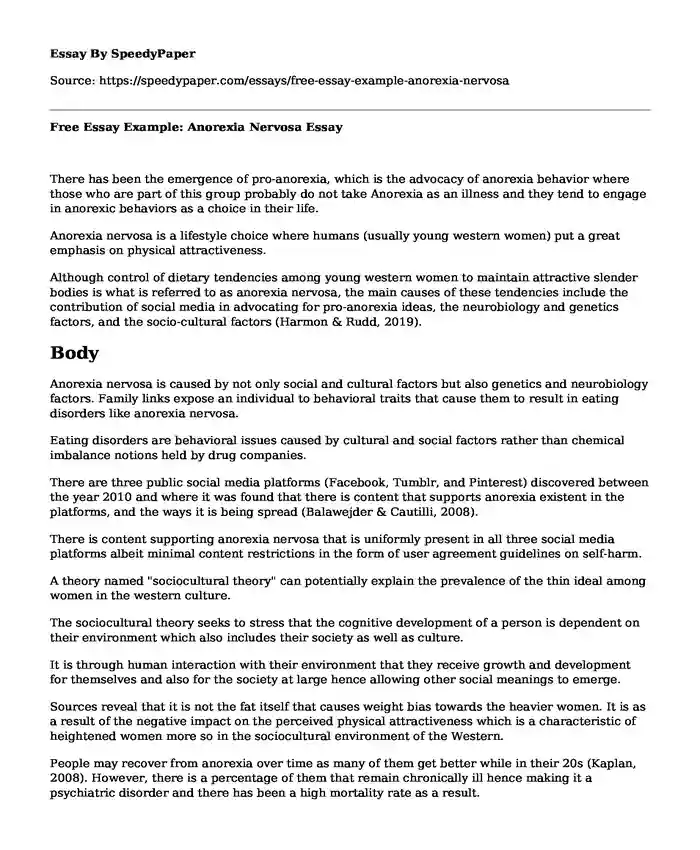
| Type of paper: | Essay |
| Categories: | Medicine Nutrition Mental disorder |
| Pages: | 3 |
| Wordcount: | 682 words |
There has been the emergence of pro-anorexia, which is the advocacy of anorexia behavior where those who are part of this group probably do not take Anorexia as an illness and they tend to engage in anorexic behaviors as a choice in their life.
Anorexia nervosa is a lifestyle choice where humans (usually young western women) put a great emphasis on physical attractiveness.
Although control of dietary tendencies among young western women to maintain attractive slender bodies is what is referred to as anorexia nervosa, the main causes of these tendencies include the contribution of social media in advocating for pro-anorexia ideas, the neurobiology and genetics factors, and the socio-cultural factors (Harmon & Rudd, 2019).
Body
Anorexia nervosa is caused by not only social and cultural factors but also genetics and neurobiology factors. Family links expose an individual to behavioral traits that cause them to result in eating disorders like anorexia nervosa.
Eating disorders are behavioral issues caused by cultural and social factors rather than chemical imbalance notions held by drug companies.
There are three public social media platforms (Facebook, Tumblr, and Pinterest) discovered between the year 2010 and where it was found that there is content that supports anorexia existent in the platforms, and the ways it is being spread (Balawejder & Cautilli, 2008).
There is content supporting anorexia nervosa that is uniformly present in all three social media platforms albeit minimal content restrictions in the form of user agreement guidelines on self-harm.
A theory named "sociocultural theory" can potentially explain the prevalence of the thin ideal among women in the western culture.
The sociocultural theory seeks to stress that the cognitive development of a person is dependent on their environment which also includes their society as well as culture.
It is through human interaction with their environment that they receive growth and development for themselves and also for the society at large hence allowing other social meanings to emerge.
Sources reveal that it is not the fat itself that causes weight bias towards the heavier women. It is as a result of the negative impact on the perceived physical attractiveness which is a characteristic of heightened women more so in the sociocultural environment of the Western.
People may recover from anorexia over time as many of them get better while in their 20s (Kaplan, 2008). However, there is a percentage of them that remain chronically ill hence making it a psychiatric disorder and there has been a high mortality rate as a result.
It is important to ensure weight restoration in the short run so as to keep patients from starving to death and do away with the withdrawal symptoms of Anorexia.
Conclusion
Although control of dietary tendencies among young western women to maintain attractive slender bodies is what is referred to as anorexia nervosa, the main causes of these tendencies include the contribution of social media in advocating for pro-anorexia ideas, the neurobiology and genetics factors, and the socio-cultural factors.
Anorexia nervosa is caused by not only social and cultural factors but also genetics and neurobiology factors. Family links expose an individual to behavioral traits that cause them to result in eating disorders like anorexia nervosa.
References
Bordo, S. (2011). The Globalization of Eating Disorder. The New World Reader: Thinking and Writing about the Global Community, Pp. 639-643. Harmon, J., & Rudd, N. A. (2019). Friending Ana: Investigating the prominence and characteristics of proanorexia communities on social media. Fashion, Style, & Popular Culture, 6(2), 243+. Retrieved from https://link.gale.com/apps/doc/A580223138/AONE?u=lirn99776&sid=AONE&xid=2463fedd
Balawejder, T., & Cautilli, J. (2008). Behavioral insights underlying mental health problems: A review of "Taking America Off Drugs" by Stephen Ray Flora: Albany, New York, State University of New York Press. The International Journal of Behavioral Consultation and Therapy, 4(1), 115+. Retrieved from https://link.gale.com/apps/doc/A214102582/AONE?u=lirn99776&sid=AONE&xid=eb316b13
Kaplan, A. (2008, January). Why girls starve themselves: new research in anorexia nervosa. Psychiatric Times, 25(1), 1. Retrieved from https://link.gale.com/apps/doc/A180317152/AONE?u=lirn99776&sid=AONE&xid=f6f36b08 Spara, L.
Cite this page
Free Essay Example: Anorexia Nervosa. (2023, Mar 14). Retrieved from https://speedypaper.net/essays/free-essay-example-anorexia-nervosa
Request Removal
If you are the original author of this essay and no longer wish to have it published on the SpeedyPaper website, please click below to request its removal:
- Free Essay on Ben Franklin, Powerpoint Ppresentation Text
- Essay Sample to Check: Current Environmental Issues and Possible Solutions
- Free Essay That Includes the Interview on Islamic Religion
- Legal Issues at a Pediatric Clinic, Free Essay in Healthcare Management
- Essay Sample for Students: Health Disparities of Native Americans
- Essay Example about Rheumatic Arthritis and Its Treatment
- American Colonial Painters Essay Sample
Popular categories




